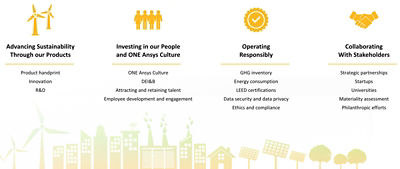-
United States -
United Kingdom -
India -
France -
Deutschland -
Italia -
日本 -
대한민국 -
中国 -
台灣
-
Ansysは、シミュレーションエンジニアリングソフトウェアを学生に無償で提供することで、未来を拓く学生たちの助けとなることを目指しています。
-
Ansysは、シミュレーションエンジニアリングソフトウェアを学生に無償で提供することで、未来を拓く学生たちの助けとなることを目指しています。
-
Ansysは、シミュレーションエンジニアリングソフトウェアを学生に無償で提供することで、未来を拓く学生たちの助けとなることを目指しています。
ANSYS BLOG
September 23, 2022
Accelerating a Sustainable Future With Simulation
The word “sustainability” calls to mind various aspects of the whole for most people. You may think of wind farms, recycling, electric vehicles, or planting trees — but it is really all that and more. Sustainability encompasses everything involved in meeting our current needs without preventing future generations from doing the same. In short: Sustainability isn’t just about preserving our natural resources; it’s about sustaining humankind.

Sustainability is about meeting the needs of future generations.
That’s a monumental undertaking, but it’s something simulation helps to make possible across the product life cycle by speeding time to market, ensuring resources are used efficiently, reducing product footprints, and saving costs. Simulation is essential to showing precisely how products will work, enabling innovators to move confidently from new ideas to reality at the pace our planet needs now. It helps engineering teams understand how to conserve resources and lower emissions when improving existing products. Reaching beyond the design and development stage, simulation also shows how companies can follow more efficient practices to make manufacturing, operations, and end-of-life processes more environmentally responsible.
Like any massive challenge, progress toward sustainability goals is easier to make and track by breaking it into more manageable parts. At Ansys, we have created a two-pronged approach to our sustainability efforts:
- Advancing Ansys’ environmental, social, and government (ESG) objectives
- Supporting Ansys customers in achieving their sustainability goals via simulation
Both areas are divided into four pillars.
Ansys’ Commitment to ESG
By integrating ESG objectives into our decision making, we can deliver long-term value for our business and our communities. Our core ESG pillars are listed below and you can learn more about them here.
- Advancing sustainability through our products
- Investing in our people and ONE Ansys culture
- Operating responsibly
- Collaborating with stakeholders

Ansys is committed to meeting environmental, social, and government (ESG) objectives.
The world’s sustainability goals are something we all need to work together to achieve. Sustainability connects industries, technologies, governments, and cultures. Ansys has developed a broad, open ecosystem that supports sustainability innovation via our 300 technology partners, more than 1,550 companies in our startup program, and more than 3,300 universities that use Ansys software. Together, with our customers and partners, we aim to enable a more sustainable future, faster.
Supporting our Customers’ Success
Ansys customers from virtually every industry are using simulation as a superpower to meet their sustainability goals. Companies in the energy sector are reducing greenhouse gas emissions, improving low-carbon energy alternatives, and optimizing operations with digital twins that are enabled by simulation and artificial intelligence. Automakers are transforming into electric mobility companies, while improving aerodynamics and reducing vehicle weight to improve range. The aerospace industry is exploring new propulsion and fuel storage solutions while implementing advanced manufacturing and model-based system engineering. The high-tech sector is using simulation to design more energy efficient electronics that are designed with material intelligence to improve e-waste recovery. And heavy industry, which makes the industrial machines and materials that are used to make products for other industries, are transitioning to digital workflows that rely on the industrial internet of things to optimize operations, save energy, and control pollution.
Because so many customers across industry sectors are applying simulation to their sustainability efforts, we have divided our sustainability-focused solutions into four pillars:
1. Clean Environment, which includes Ansys solutions that help our customers filter pollution out of our environment, use energy more efficiently, and even capture carbon from the air.
2. Materials and Circularity solutions that are revolutionizing the way customers create, manufacture, sell, recapture, sort, and reuse products to design waste out of our shared future.
3. Energy Solutions that enable our customers to drive the decarbonization of energy systems by providing technical leverage to transition to energy-efficient and renewable solutions.
4. Manufacturing and Operational Efficiency solutions that help manufacturers plan and optimize operations to use materials more efficiently and improve reliability, which reduces power consumption and emissions.

Ansys simulation solutions help advance sustainability in these four key areas.
The use of simulation by our customers to reduce their own carbon footprint and the footprint of their products is nearly infinite. You can see some of their success stories in our online series, Earth Rescue, or in the blogs, case studies, and webinars available in our resource center. We are excited to work with our expansive ecosystem of partners and customers to deliver the predictive insights of simulation, whenever and wherever they’re needed, to accelerate the next great leaps in human advancement.










